Volkswagen Jetta
The Volkswagen Jetta (![]()
| Volkswagen Jetta | |
|---|---|
 | |
| Overview | |
| Manufacturer | Volkswagen |
| Production | 1979–present |
| Body and chassis | |
| Class | Compact car (C) |
| Platform | Volkswagen Group A platform |
The Jetta has been offered in two- and four-door saloon / sedan, and five-door wagon / estate versions – all as four- or five-seaters. Since the original version in 1980, the car has grown in size and power with each generation.[1] By mid-2011, almost 10 million Jettas have been produced and sold all over the world. As of April 2014, Volkswagen marketed over 14 million, becoming its top selling model.[2]
Nameplate etymology
Numerous sources note that the Jetta nameplate derives from the Atlantic 'jet stream' during a period when Volkswagen named its vehicles after prominent winds and currents (e.g., the Volkswagen Passat (after the German word for trade wind), Volkswagen Bora (after bora), and Volkswagen Scirocco (after sirocco).[3]
A 2013 report by former VW advertising copywriter Bertel Schmitt, said that — after consulting VW sources including Dr. Carl Hahn, former Volkswagen of America Chief and W.P. Schmidt, former sales chief at Volkswagen — no evidence suggested Volkswagen employed a naming theme for its front-drive, water-cooled vehicles; nor was there evidence the names derived from a theme; nor that a naming system "was ever announced, either officially or confidentially."[4]
First generation (A1, Type 16; 1979–1984)

Although the Golf reached considerable success in the North American markets, Volkswagen observed the hatchback body style lacked some of the appeal to those who preferred the traditional three-box configuration. The styling of the 1970 AMC Gremlin was controversial for truncating the Hornet sedan, but Volkswagen stylists reversed the process by essentially grafting a new trunk onto the tail of the Golf to produce a larger Jetta saloon.[5] The Jetta became the best-selling European car in the United States, Canada, and Mexico.[6][7] The car was also popular in Europe, including the United Kingdom, Germany, and Turkey.[8]
The Jetta was introduced to the world at the 1979 Frankfurt Auto Show.[9] Production of the first generation began in August 1979[10] at the Wolfsburg plant.[11] In Mexico, the Mark 1 was known as the "Volkswagen Atlantic".
The car was available as a two-door sedan (replacing the aging rear-engined, rear-wheel drive Volkswagen Beetle 2-door sedan in the United States and Canada) and four-door sedan body styles, both of which shared a traditional three-box design. Like the Volkswagen Golf Mk1, its angular styling was penned at ItalDesign, by Giorgetto Giugiaro. Styling differences could be found depending on the market. In most of the world, the car was available with composite headlamps, while in the US, it was only available with rectangular sealed beam lamps due to Federal Motor Vehicle Safety Standard 108 (FMVSS 108). The suspension setup was identical to the Golf and consisted of a MacPherson strut setup in front and a twist-beam rear suspension. It shared its 2,400 mm (94.5 in) wheelbase with its hatchback counterpart, although overall length was up by 380 millimetres (15 in). The capacity of the luggage compartment was 377 litres (13.3 ft3), making the Jetta reasonably practical.[12] To distinguish the car from the Golf, interiors were made more upscale in all markets.[13] This included velour seating and color coordinated sill to sill carpeting.
Engine choices varied considerably depending on the local market. Most were based on 827 engines of the era. Choices in petrol engines ranged from a 1.1 litre four-cylinder engine producing 37 kW (50 hp; 50 PS), to a 1.8-litre I4 which made 82 kW (110 hp; 111 PS) and 150 newton metres (111 lbf⋅ft) of torque. Some cars were equipped with carburetors, while others were fuel-injected using K or KE Jetronic supplied by Robert Bosch GmbH. Diesel engine choices included a 1.6-litre making 37 kilowatts (50 hp; 50 PS) and a turbocharged version of the same engine which produced 51 kilowatts (68 hp; 69 PS) and 130 newton metres (96 lbf⋅ft) of torque.
Volkswagen briefly considered producing the Jetta in a plant located in Sterling Heights, Michigan in the US.[14] However, due to declining sales in North America, the decision was postponed and abandoned in 1982.[15] The site was subsequently sold to Chrysler in 1983 and was in operation as of 2009.[16] This generation was also produced in SFR Yugoslavia, Bosnia and Herzegovina, under the joint venture Tvornica Automobila Sarajevo (TAS) for the Balkan area.[17]
Second generation (A2, Typ 20E/1G; 1984–1991)
The Mark 2 series is the longest running Jetta so far. Introduced to Europe in early 1984 and to North America in 1985, the second generation Jetta proved to be a sales success for Volkswagen. The car secured the title of best-selling European car in North America, Farmer's Journal COTY 1991 and outsold the similar Golf by two-to-one in that market.[18] Based on the all new second generation Golf platform, the car was larger, heavier, and could seat five people instead of four as in the Mark 1. Exterior dimensions increased in all directions. Overall length was up by 100 mm (3.9 in), the wheelbase grew 66 mm (2.6 in), and the width went up 53 mm (2.1 in). The suspension setup was basically unchanged from the first generation, although refined slightly, for example by the inclusion of a separate subframe for mounting the front control arms to help noise isolation, as well as improved rubber mountings for all components. Aerodynamics improved considerably, with a drag coefficient of 0.36.[19] With a 470-litre (16.6 ft3) luggage compartment, the trunk had grown nearly as large as some full-sized American sedans.[20] Interior room was also increased 14%, which changed the EPA class from sub-compact to compact.
Cars built in Germany were assembled in a brand new (at the time) plant at Wolfsburg in Assembly Hall 54. The plant was heavily robotised in an effort to make build quality more consistent.[21] New innovations on the second generation included an optional trip computer (referred to as the MFA, German Multi-Funktions-Anzeige), as well as silicone dampened engine and transmission mounts to reduce noise, vibration, and harshness levels. In 1988, a more advanced fully electronic fuel injection system became available. This arrangement is known as the Digifant engine management system.
Like the Mark 1, the second generation was offered as a two-door or four-door sedan. External changes throughout the series' run were few: the front-quarter windows were eliminated in 1988 (along with a grille and door trim change), and larger body-colored bumpers and lower side skirts were added from 1990.
In 2007, Volkswagen of America held a contest to find the diesel-powered Volkswagen with the highest distance traveled on the original engine.[22] The winning car was a 1986 Jetta Turbodiesel found in Blue Rock, Ohio which had 562,000 miles (904,000 km).[23] A local dealer verified the odometer reading. Notable on this particular car was that it also had the original muffler despite being located in an area subject to road salt in the winter.
Third generation (A3, Typ 1H; 1992–1999)

For the third generation, the Jetta name was discontinued, and it was officially renamed the Volkswagen Vento in European countries, following the precedent of naming cars after winds, debuted in 1992. The Jetta 3 debuted in North America in 1993 after production delays and quality problems at the Volkswagen plant in Puebla, Mexico.[24] The name "Vento" means "wind" in both Portuguese and Italian. It went on sale in most of Europe in the first quarter of the year, though it did not arrive on the British market until September 1992.
Because of the success of the second generation in North America, Volkswagen decided to keep the Jetta nameplate. However, in Europe the car was given its new name to appeal to a younger market.[25]
Styling was penned by a design team led by Herbert Schafer, and again the car became more aerodynamic than the previous generation. Although visually similar to the Mark 2, there were many refinements underneath. The two-door model was dropped, aerodynamics were improved, with the car now having a drag coefficient of 0.32.[26] This included a new structure which now met worldwide crash standards.[27] Suspensions were an evolutionary rather than revolutionary refinement of the setup on previous editions, and mainly consisted of a wider track, and even maintaining backwards compatibility with older models. In addition, the car became more environmentally friendly with the use of recycled plastics, CFC-free air conditioning systems, and paint that did not contain heavy metals.[28]
This generation of the car is widely credited for keeping Volkswagen from pulling out of the North American market.[24][29] At the time of its introduction in 1993, Volkswagen of America's sales hit a low not seen since the 1950s. The division sold only 43,902 cars in that year. Sales began slowly due to the aforementioned issues at the Puebla plant.[30] However, sales rebounded dramatically in the following years, mostly based on the strength of the Jetta, which continued to be the best-selling Volkswagen in the USA.[31]
Fourth generation (A4, Typ 1J; 1999–2005)
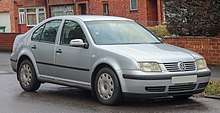
Production of the fourth generation car began in July 1999.[32] Carrying on the wind nomenclature, the car was known as the Volkswagen Bora in much of the world. Bora is a winter wind which blows intermittently over the coast of the Adriatic Sea, as well as in parts of Greece, Russia, Turkey, and in the Sliven region of Bulgaria. In North America and South Africa, the Jetta moniker was again kept on due to the continued popularity of the car in those markets.
The Mk4 debuted shortly after its larger sibling, the Passat, with which it shared many styling cues. The rounded shape and arched roofline served as the new Volkswagen styling trademark, abandoning traditional sharp creases for more curved corners. A distinguishing feature of the Mk4 is its Whiptenna, a trademark for the antenna on the rear end of the roof, which claims to incur less drag than traditional antennas due to its short length and leeward position. For the first time, the rear passenger doors differed from those of a 5-door Golf. The car was also offered as an estate/wagon (whose rear doors are also non-interchangeable with the others). New on this generation were some advanced options such as rain sensor controlled windshield wipers and automatic climate control. However, these were expensive extras and many buyers did not specify them on their cars; as a result the used market has many sparsely equipped models.
Although slightly shorter overall than the Mark 3, the fourth generation saw the wheelbase extended slightly. Some powertrain options were carried over. Nevertheless, two new internal combustion engines were offered, the 1.8-litre turbo 4-cylinder (often referred to as the 1.8 20vT), and the VR6. The suspension setup remained much as before. However, it was softened considerably in most models to give a comfortable ride, which was met with some criticism as it was still quite hard in comparison with rivals such as vehicles offered from French car makers.[33]
Fifth generation (A5, Type 1K5; 2005–2011)
.jpg)
The fifth generation debuted at the Los Angeles Auto Show on 5 January 2005. After the New Beetle, it was the second Volkswagen product to make its world debut at a U.S. auto show.[34] The Mark 5 sedan went on sale in the USA prior to any other country, reflecting the importance of the car in that market for Volkswagen.[35] VW spent US$800 million to upgrade its Puebla facilities for this model's production. This included a US$290 million new engine production line for the 5-cylinder power plant, a US$50 million investment in the press shop, as well as a US$200 million purchase of 460 robots, which increased automation by 80%.
Although produced in the largest volumes in Mexico, final assembly of the car also takes place in China and South Africa for those respective markets.[36] Like initial production of the second generation in China, the Asian and African plants build the car from a complete knock down (CKD) kit shipped from the factory in Puebla. Local assembly in Kaluga, Russia, started in early 2008.[37] Production also began in India in 2008.[38] Currently, the Škoda factory in Aurangabad is used for final assembly.[39] As with the previously mentioned assembly plants, CKD kits from Volkswagen de México will be used.
In most countries, the fifth generation is marketed as the Jetta. Exceptions to this include "Bora" in Mexico and Colombia, "Vento" in Argentina and Chile, and "Sagitar" in China.[40][41][42] The Mark 5 is 170 millimetres (6.7 in) longer, 30 millimetres (1.2 in) wider, and has a 70 millimetres (2.8 in) longer wheelbase than the previous iteration. Interior room has increased from 2.46 cubic metres (87 cu ft) to 2.58 cubic metres (91 cu ft). In particular, rear legroom was increased by 65 millimetres (2.6 in) over the fourth generation. Luggage compartment volume is up to 453 litres (16 cu ft). One major change is the introduction of the first multi-link independent rear suspension in a Jetta. The design of the rear suspension is nearly identical to the one found in the Ford Focus.[43] Volkswagen reportedly hired engineers from Ford who designed the suspension on the Focus.[33]
Styling reflects a new direction for the Volkswagen brand, with a new chrome front grille, first seen on the Volkswagen Golf Mk5 R32, which has spread to other models.[44] Some critics appreciated the new styling, whilst others dismissed it as just as bland as the 4th generation.[45][46]
For model year 2009, certain markets saw a new base model internal combustion engine and automatic transmission. The previous 2.0-litre four-cylinder engine, and six-speed automatic transmission, were replaced with a smaller, more powerful, and more fuel efficient, 1.4-litre turbocharged four-cylinder engine, and six-speed DSG transmission (the same as used in the new Golf Mk5). As a result of the change, fuel consumption has been improved (by 17% for the manual, from 8.2 L/100 km (34 mpg‑imp; 29 mpg‑US) down to 6.8 L/100 km (42 mpg‑imp; 35 mpg‑US)), and 23% for the automatic, from 8.6 L/100 km (33 mpg‑imp; 27 mpg‑US) down to 6.6 L/100 km (43 mpg‑imp; 36 mpg‑US). Power has increased 7%, from 110 kW (148 hp; 150 PS), to 118 kW (158 hp; 160 PS), while torque is up 20%. In addition, acceleration times 0-100 km/h (0-62 mph) have improved, from 9.2 s to 8.5 s for the manual (an 8% improvement), and from 9.9 s to 8.5 s for the automatic (a 14% improvement).
Sixth generation (A6, Type 5C6; 2011–2019)
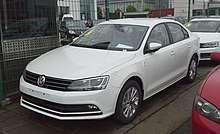
The sixth-generation Volkswagen Jetta, known as the NCS (New Compact Sedan) during its development, was announced in the North American market on 16 June 2010.[47] The new model was larger and less expensive to manufacture than the previous generation[48] making the vehicle more competitive against rivals such as the Toyota Corolla, Honda Civic and Nissan Sentra[49] as part of Volkswagen's goal of reaching sales of 800,000 units in the North American market by 2018.[48] Production of the vehicle is at Volkswagen's Puebla, Mexico, facility.[47] The sixth generation Volkswagen Jetta was primarily designed by Volkswagen Mexico under the supervision of Volkswagen Germany and 70% of the parts are designed and manufactured in Mexico.[50]
Although no longer sharing any body panels with the Golf and having a longer wheelbase, this generation was partly based on the same PQ35 platform.
Volkswagen's target of increasing its North American sales removed the Jetta from the premium compact car market. This forced many cost-cutting measures to be made for the North American models, which included a lower quality trim material for the interior and the replacement of leather with leatherette as an optional seating upholstery. Leather was still available on Canadian-spec models. The North American version also lost the multi-link rear suspension of the previous generation.[51] Engines from the MK5 Jetta carried over included the 127 kW (170 hp; 177 PS) 2.5 L (five-cylinder) as well as the economy-minded 104 kW (140 hp; 142 PS) 2.0 TDI (diesel) engine. A Turbo Hybrid, 111 kW (149 hp; 151 PS) 1.4 L TSI intercooled turbocharged engine mated with a 20 kW (27 hp; 27 PS) electric motor providing a combined 127 kW (170 hp; 173 PS) and 249 N⋅m (184 ft⋅lb) became available in 2013, due to Hybrid popularity in North America. Additionally, the SEL Premium model retains the upscale soft touch interior, as well as the multi-link independent rear suspension found on the GLI, though softened for a more comfortable ride. It also has as standard a 6-speed sequential manual DSG gearbox, with Sport and Tiptronic modes. The Jetta Turbo Hybrid has an estimated combined fuel economy of 5.2 L/100 km (54 mpg‑imp; 45 mpg‑US).[52] The 2013 Volkswagen Jetta Turbo Hybrid was unveiled in January 2012 at the North American International Auto Show.
In North America, the base model (S in the US, Trendline in Canada) received a 2.0-liter 8-valve four-cylinder engine with 86 kW (115 hp; 117 PS) and 169 N⋅m (125 lbf⋅ft) torque. Sales of the 2013 model year Jetta Turbo Hybrid are scheduled to begin in the U.S. by late 2012.[53] From model year 2016 onward, American S and SE models, and Canadian models Trendline and Comfortline Jettas would receive a 1.4 liter turbocharged engine that produces 148 hp (150 PS; 110 kW) and 184 lb⋅ft (249 N⋅m) of torque. This engine replaced the 2.0-litre in those markets.[54]
Seventh generation (A7, 2019–present)

The seventh-generation 2018 Volkswagen Jetta debuted at the 2018 North American International Auto Show in Detroit, Michigan, on 14 January 2018, after Volkswagen released an exterior design sketch in December 2017. The Jetta is based on Volkswagen's MQB Platform, which underpins other Volkswagen vehicles including the Volkswagen Golf and the Volkswagen Atlas. [55]
The Mk7 is larger than its predecessor, offers more interior room and has the latest generation of Volkswagen's infotainment systems, including integration of Apple CarPlay and Android Auto. Its ten-color customizable ambient interior lighting includes lighting across the dashboard and instrument panel, front and rear doors, foot wells, and the gauge "rings" of a newly available fully digital instrument cluster display, marketed as the "Digital Cockpit". Reflector LED headlamps and LED rear tail lamps are standard equipment, and a panoramic sunroof is also available. Heated and ventilated front seats are available as well, as leather-trimmed seating surfaces become available for the first time since the Mk. V Jetta. In addition, Volkswagen is the second automaker in the U.S. to offer a premium Beats Audio audio system, and also offers advanced safety technologies such as adaptive cruise control (ACC), blind spot monitoring (BLIS), light assist, lane assist, and rear cross-traffic alert.
The Jetta's 1.8 L turbocharged TSI inline four-cylinder (I4) gasoline engine has been discontinued, as the outgoing 147 hp (110 kW) 1.4 L turbocharged TSI inline four-cylinder (I4) is the only engine option on the Jetta. Only the base S trim is offered with a six-speed manual transmission or an eight-speed automatic transmission, while all other trims offer only an eight-speed automatic transmission. On higher trim levels, the Jetta also offers seventeen-inch aluminum-alloy wheels, and Volkswagen Driving Mode Selection. There is also Cross Differential System (XDS), but it is only available on the Jetta R Line.[56]
Safety features on the Jetta include an Intelligent Crash Response System (ICRS), and a standard safety cage. An automatic post-collision braking system, a tire pressure monitoring system (TPMS), as well as seven safety and stability-enhancing systems all come as standard equipment.
Trim levels of the all-new Jetta in the U.S. are S, SE, R-Line, SEL, and SEL Premium. Trim levels in Canada are Comfortline, Highline and Execline. All trim levels lost the multi-link rear independent suspension for a less expensive torsion-beam rear suspension.[57]
The Jetta GLI was introduced on April 7th, 2019, at the Chicago Auto Show. The GLI features the 228 hp (170 kW) EA888 engine. It also features a few exterior changes, such as a different bumper. It now has a VAQ electronic limited slip differential and a multi-link independent rear suspension.
As with its predecessors, production of the all-new 2019 Jetta will continue at Volkswagen's Puebla, Mexico Assembly Plant. The all-new Jetta will reach Volkswagen dealerships in the U.S. in the second quarter of 2018. A GLI model with a multi-link rear suspension is expected to come as a 2020 model. However, this new seventh generation Jetta will not be sold in the European market.
The Chinese-spec Volkswagen Sagitar Long-Wheelbase was launched in January 19, 2019 both in Beijing and Shanghai; it is about 50 mm longer than the U.S.-spec model, and is equipped with independent suspension.[58] This is an attempt to occupy the more upscale market than the also-MQB SAIC-VW Volkswagen Lavida, which share similar looks. Production continues in the FAW-VW Chengdu Plant.[59]
Alternative-propulsion cars
In 2001, at the 18th International Electric Vehicle Symposium and Exhibition in Berlin, Volkswagen released two environmentally friendly cars: the Bora HyMotion and the Bora Electric.
The Bora HyMotion was a hydrogen powered Mark 4 with a 75 kW fuel cell that could accelerate from 0 to 97 km/h (60 mph) in 12.5 seconds. With a 49-litre tank of cryogenically stored hydrogen, it had a range of 350 km (220 mi). Top speed was 140 km/h (87.0 mph).[60]
In 2002, Volkswagen, along with Paul Scherrer Institute released another hydrogen powered car called the Bora Hy.Power. The car was powered by hydrogen compressed to a pressure of 320 bar (4600 psi). It had ratings very similar to the HyMotion; with a 75 kW (101 hp) power source. A special feature of the car was a 60 kilowatt super capacitor which could boost power when needed and also recover energy when coasting.[61]
Volkswagen had considered producing a mild hybrid version of the fifth generation mainly for the North American market but never produced it.[62] In 2013 Volkswagen produced a turbocharged full hybrid sixth generation offering for the North American market.
Biofuels

Volkswagen released a Jetta MultiFuel in 1991, at first to the governments of the state of California and New York, and then for limited retail sale in those states to the public. They are an early example of an E85 vehicle, burning a mixture of 85% ethanol and 15% gasoline. These Jettas can still be found on U.S. roads.
Volkswagen also released a Bora TDI which was powered by SunFuel, a synthetic fuel developed in partnership with Royal Dutch Shell.[63] The company also displayed Bora TDI powered by SunDiesel that Volkswagen also developed with DaimlerChrysler along with Choren Industries.[64]
Use of the two most popular blends of Biodiesel that are mostly Biodiesel, B80 and B100, is not recommended in 2009 and 2010 US TDI engines.
In Brazil, until 2015, the Jetta was sold with the 2.0 L flex-fuel (marketed as "Total Flex") engine in Trendline and Comfortline trims. It could run on either E100 or Petrol. From 2016 model year onwards, the 2.0 L flex-fuel was replaced by the 1.4 L TSI turbocharged engine from EA211 family, that runs exclusively on petrol.[65]
Electric vehicle
In the early 1980s, Volkswagen released a limited production electric Jetta called the Jetta CityStromer. It featured a 24.8 hp (18.5 kW) powertrain (later 37.5 hp (28 kW)), with a range of 190 km (250 km in the later version).[66]
The second concept vehicle was called the Bora Electric. It had a power rating that varied according to the operating conditions. The Bora Electric could accelerate from 0 to 100 km/h in 10 seconds with a range of 160 km. It was powered by a Lithium-ion battery. It was noted that its chance of success was limited in the marketplace given the high cost of the electric drive system.[67]
Awards and recognition
In November 2008 the VW Jetta TDI (clean diesel) won the 2009 Green Car of the Year awarded by Green Car Journal.[68] As a result of the Volkswagen emissions scandal the award was rescinded.[69]
Motorsport
From 2008 through 2010, Volkswagen and the Sports Car Club of America hosted the Volkswagen Jetta TDI Cup, using factory prepared 2009 Jetta TDIs.
For the 2010 SCCA World Challenge season, Irish Mike's Racing is campaigning GLIs in the touring car class. Todd Buras won rounds 1 and 2 at the Grand Prix of St. Petersburg[70] and round 10 at Virginia International Raceway[71] while Chip Herr won round 4 at Mosport.[72]
Recalls
On 30 September 2011, Volkswagen of America announced a recall involving 2009–2012 Jetta and Jetta Sportwagen models with the 2.0L TDI engine; this recall pointed to a resonance condition with the number 2 fuel injector line and the fuel injector pulses, causing small cracks in the line which could leak.[73]
Volkswagen emissions violations recall
In September 2015, it was discovered that some Volkswagen TDIs had exceeded the United States legal emissions limits. These emissions violations, which would later be referred to as Volkswagen's "emissionsgate" or "dieselgate", affected the 2.0 L TDI diesel engines (the engines from 2008 that would later be in the Volkswagen TDIs in North America).[74]
Use in China
The Jetta has been built and produced in China since December 1991 by FAW-VW, and the Jetta name itself has been used by FAW-Volkswagen as a new automotive brand starting in 2019.
Jetta A2
The first known Jetta was the A2 model that was used as a passenger car and a taxicab.
The A2 was then given a facelift in April 1997 where it was known as the Jetta King. Available engines were a 1.6 litre petrol engine called the EA113 for civilian cars and a 1.9 litre diesel engine only available for taxi models. A 4-speed manual gearbox was standard, which could be replaced by a 5-speed manual gearbox, and then a 4-speed automatic gearbox was made available from November 1998. For 2002, the Jetta King was facelifted with a new exterior. Trim levels consisted of the AT, ATF, Avantgarde, CDX, CiF, CiX, CT, GDF, GiF, GT, GTI, GTX and Meeresbrise. This model was also converted into a 2-door pickup truck in limited numbers.
The A2 was facelifted again in March 2010 with the same engines used by its predecessor; it was known as the Jetta Pioneer. This version of the Jetta was not offered in different trim levels and was a single model for the Chinese market. A2-based Jetta production ended in March 2013 where it was replaced by an independent model using the Volkswagen Group A05+ platform.


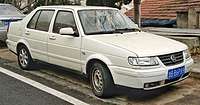
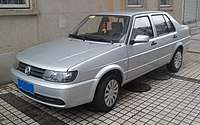
Bora A4
The second known Jetta was the A4 model sold under the Bora name which commenced production in December 2001. It was given a facelift in 2006 and was available with the 1.6 and 1.8 litre EA113 petrol engine and a 1.9 litre diesel engine. A 5 speed manual was available alongside a 4 speed automatic gearbox. A hatchback version was known as the Bora HS and was a badged Volkswagen Golf Mk4. Production for the first generation Bora ended in 2006 while the Bora HS ended production in 2008.
The Bora was facelifted in 2007 with two new engines, a 1.4 litre turbo and a 1.6, under the EA111 name. A 5 speed and 6 speed manual was standard alongside a 7 speed dual clutch automatic gearbox. Production ended in 2015.
The third generation Bora commenced production in 2015 for the 2016 model year with a new exterior and interior. 1.4, 1.5 and 1.6 litre engines were standard paired to 5 and 6 speed manual and a 7 speed dual clutch automatic gearbox. This generation is still available as of May 2019 as the Bora Classic with three trim levels.
The fourth generation Bora was produced since April 2018 and used Volkswagen's MQB platform. 1.4 and 1.5 litre engines were standard paired to a 6 speed manual and 7 speed dual clutch automatic gearbox.
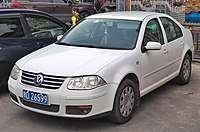
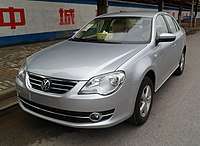
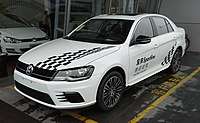

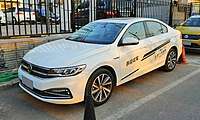
Sagitar
The third known Jetta example was known as the Sagitar and has been produced since April 2006. The Sagitar is a rebadged Mk5 and Mk6 and Mk7 Jetta using Volkswagen's PQ35 platform. For the Mk5 Sagitar, a 1.6 litre engine was standard alongside a 1.8 litre turbo and 2 litre engine. The 2.0 litre was removed in 2009 to make way for a 1.4 litre turbocharged engine. Available gearboxes were a 5 speed manual, 6 speed automatic and 7 speed dual clutch gearbox. The Mk6 Sagitar entered the market in March 2012. The Sagitar was available with the 1.4 litre turbo and 1.6 litre engine paired with a 5 speed manual gearbox for both engines, 6 speed automatic gearbox for 1.6 models and 7 speed dual clutch for 1.4 models. 1.8 TSI models were available for 2014 followed by the 2.0 litre TSI for 2016 and 1.2 TSI for 2017 and 2018. The 2.0 litre TSI engine and 6 speed DSG combination is standard on Sagitar GLi models while the 1.4 litre turbo with 7 speed dual clutch gearbox is available on Sagitar R-Line models. The Mk6 Sagitar ended production in September 2019. Its successor, the Mk7 Sagitar was launched in January 2019. A 1.4 and 1.5 litre EA211 engine was standard paired to a 5 speed manual and 6 speed automatic gearbox.

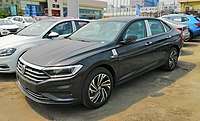
See also
- Volkswagen Jetta (China)
- List of modern production plug-in electric vehicles
References
- "All-new Jetta makes worldwide debut at L.A. Auto Show" (Press release). Volkswagen of America. 5 January 2005. Archived from the original on 24 July 2005. Retrieved 3 September 2009.
- "2015 VOLKSWAGEN JETTA MAKES GLOBAL DEBUT AT THE NEW YORK INTERNATIONAL AUTO SHOW". Volkswagen Media Centre. Archived from the original on 15 April 2014. Retrieved 14 April 2014.
- "Jetta History". Volkswagen AG. 7 January 2004. Archived from the original on 28 September 2007. Retrieved 3 September 2009.
- "Inside The Industry: TTAC Finds The Missing Etymology Of Passat, Golf, Scirocco, Polo". The Truth About Cars, Bertel Schmitt, 24 May 2013.
- Vack, Peter (1993). Illustrated Volkswagen Buyer's Guide. Osceola, Wisconsin USA: Motorbooks International. p. 124. ISBN 0-87938-724-6.
- "IN BRIEF: THE NEW JETTA" (Press release). Volkswagen AG. 15 August 2005. Archived from the original on 16 December 2005. Retrieved 3 September 2009.
- "Jetta arriba en julio y agosto". CNN Expansion. 9 September 2008.
- "The Jetta" (Press release). Volkswagen AG. 4 March 2008. Retrieved 4 September 2009.
- "Volkswagen writes history". D-28436 Wolfsburg: Volkswagen Kommunikation Briefach. 1998. Cite journal requires
|journal=(help)CS1 maint: location (link) - ETKA
- Grieger, Manfred (2003). Volkswagen Chronicle Volume 7. Wolfsburg, Germany: Volkswagen AG, Group Communications, Corporate History Department. p. 107. ISBN 3-935112-11-4.
- Robson, Graham; Auto Editors of Consumer Guide (1996). Volkswagen Chronicle. Lincolnwood, Illinois, USA: Publications International, Ltd. p. 160. ISBN 0-7853-1599-3.
- Flammang, James M. (1996). VOLKSWAGEN Beetles, Buses & Beyond. Iola, Wisconsin, USA: Krause Publications. p. 219. ISBN 0-87341-419-5.
- Robson, p.168
- Grieger, p. 92
- "Sterling Heights Assembly Plant". DaimlerChrysler. July 2006. Archived from the original on 17 October 2006. Retrieved 3 September 2009.
- "Volkswagen". Archived from the original on 27 September 2007. Retrieved 3 September 2009.
- Robson, p. 182
- Smith, David C. (December 1984). "Golf, Jetta much improved and, with them, VWA's hopes". Ward's Auto World.
- "Consumer Reports". February 1986: 124. Cite journal requires
|journal=(help) - Robson, p. 186
- "VOLKSWAGEN NOW ACCEPTING APPLICATIONS FOR OLDEST AND HIGHEST MILEAGE DIESEL VEHICLES" (Press release). Volkswagen of America. 2 March 2007. Archived from the original on 28 September 2007. Retrieved 3 September 2009.
- "VOLKSWAGEN DIESEL HERITAGE SEARCH FINDS HIGHEST MILEAGE DIESEL IN OHIO" (Press release). Volkswagen of America. 23 August 2007. Retrieved 26 August 2007.
- Robson, p. 208
- Plumb, Steven E. (March 1992). "VW Jetta replacement coming next fall". Ward's Auto World.
- Visnic, Bill (December 1993). "VW's new Golf, Jetta try for a comeback". Ward's Auto World.
- Robson, p. 202
- Volkswagen Jetta. Auburn Hills, Michigan, USA: Volkswagen of America. 1993. p. 17. Form No. W63 163 6081.
- Jedlicka, Dan (5 March 1994). "Golf and Jetta Drive Revival in VW Sales". Chicago Sun - Times. p. 18.
- "Can Herbie ride again?". The Economist. 23 April 1994. p. 66.
- Robson, p. 210
- Grieger, p. 168
- Simister, John; Morgan, Andy (October 2003). "VW Golf 2.0 FSI". evo Car Reviews. Dennis Publishing Limited. Retrieved 29 May 2007.
- "ALL-NEW JETTA MAKES WORLDWIDE DEBUT AT L.A. AUTO SHOW" (Press release). Volkswagen of America. 5 January 2005. Archived from the original on 8 January 2007. Retrieved 3 September 2009.
- McCormick, John (February 2005). "VW's Mexican revolution: Volkswagen bets on a new Jetta with a big investment in its Puebla, Mexico, plant". Automotive Industries.
- Downer, Steven (24 July 2007). "Beetle's Future?". AutoWeek.
- "The Volkswagen plant in Kaluga" (Press release). 28 February 2009. Retrieved 22 August 2009.
- Master, Ammar (17 January 2008). "We are of the opinion we are right on time for the India party". liveMINT.com - WSJ.
- "India Volkswagen begins CKD Jetta assembly at Shendra plant". AutomotiveWorld.com.
- "Historia de Volkswagen de México". Volkswagen de Mexico S.A de C.V. 2005. Archived from the original on 22 April 2007. Retrieved 3 September 2009.
- "Historia Volkswagen". Volkswagen Chile. 2005. Archived from the original on 27 June 2007. Retrieved 3 September 2009.
- First Automotive Works (FAW) (9 April 2006). "Volkswagen Sagitar brings latest technology to Chinese car market". Volkswagen China. Archived from the original on 27 September 2007. Retrieved 3 September 2009.
- Askew, Mike (September 2003). "Volkswagen Golf 2.0 TDI". Auto Express. Dennis Publishing Limited. Retrieved 29 May 2007.
- "VOLKSWAGEN RELEASES FIRST OFFICIAL PHOTOS OF ALL-NEW JETTA TO ARRIVE EARLY NEXT YEAR" (Press release). Volkswagen of America. 18 November 2004. Archived from the original on 8 June 2007. Retrieved 3 September 2009.
- Kelly, Kevin (1 February 2005). "Jetta Grows Up". Ward's Auto World.
- Mar, Karl (28 March 2006). "2005.5 Volkswagen Jetta -- Victim of a Competitive Market". Edmunds Inc. Archived from the original on 7 July 2012. Retrieved 5 June 2007.
- "2011 Volkswagen Jetta Unveiled". Motorward. June 2010. Retrieved 15 June 2010.
- "Volkswagen's Future Products Revealed for 2011, 2012, and Beyond". Car & Driver. August 2009. Retrieved 6 September 2009.
- "2011 Volkswagen Jetta - Spied". Car & Driver. August 2009. Retrieved 6 September 2009.
- "VW hará auto del Bicentenario en Puebla - Negocios". CNNExpansion.com. 6 July 2010. Retrieved 16 April 2011.
- Pulman, Ben (15 June 2010). "VW Jetta (2011) first official pictures". Car Magazine. Retrieved 6 July 2010.
- Seabaugh, Christian (9 January 2012). "2013 Volkswagen Jetta Hybrid". Motor Trend. Retrieved 15 January 2012.
- Lienert, Anita (5 October 2012). "New 2013 Volkswagen Jetta Hybrid Pricing Announced". Edmunds.com Inside Line. Retrieved 21 October 2012.
- "www.auto-brochures.com 2016 VW Jetta PDF Brochure" (PDF).
- "Meet the all-new 2019 VW Jetta - Volkswagen". www.vw.com.
- "ALL-NEW 2019 VOLKSWAGEN JETTA USES ADVANCED, AFFORDABLE TECHNOLOGY TO IMPROVE FUEL ECONOMY". Retrieved 10 August 2018.
- "VW.com - Build Your Own". www.vw.com.
- "FAW-VW Chinese Site: Sagitar LWB Overview".
- "2019年上市 一汽-大众新速腾白车身下线".
- "Fuel cells start to look real". —. Society of Automotive Engineering. Archived from the original on 28 September 2007. Retrieved 24 April 2007.CS1 maint: extra punctuation (link)
- Menzel, p. 56
- Meiners, Jens (30 May 2005). "VW may offer Jetta hybrid". Automotive News. p. 1.
- Menzel, p. 47
- "THE NEW VOLKSWAGEN ENVIRONMENTAL REPORT 2003/2004 – PARTNERS IN RESPONSIBILITY" (Press release). Volkswagen AG. 11 December 2003. Archived from the original on 8 June 2007. Retrieved 6 September 2009.
- "VW Jetta com motor TSI 1,4 de 150 cv parte de R$ 78,2 mil" (in Portuguese). Best Cars. 29 January 2016. Retrieved 9 May 2017.
- "Elektromobil Volkswagen JETTA CityStromer" (in Czech). Đ DVOHAPER & Mobilcompany. 2005. Archived from the original on 14 October 2007. Retrieved 25 April 2007.
- Menzel, Ulrich (December 2003). Volkswagen Environmental Report 2003/2004 (PDF). Wolfsburg, Germany: Druckhaus Friedr. Schmücker GmbH, Löningen. p. 54. 415.1240.01.18. Archived from the original (PDF) on 8 November 2005. Retrieved 20 November 2009.
- "VW Jetta Clean Diesel Wins 2009 Green Car of the Year!". Green Car Journal. 21 November 2008. Archived from the original on 14 May 2010. Retrieved 2 May 2010.
- "Green Car Journal Strips Volkswagen, Audi of Awards". 30 September 2015.
- "Buras, Irish Mike's Racing VW Double In St. Petersburg". Archived from the original on 24 December 2010.
- "Buras Makes Triumphant Return To Touring Car At VIR". Archived from the original on 18 September 2010.
- "Pobst, Heinricy and Herr Win World Challenge One At Mosport". Archived from the original on 3 December 2010.
- "Stop-sale and recall: Volkswagen Golf, Jetta diesels cars for risk of fuel leak".
- Paul Nieuwenhuis (23 September 2015). "How this clean air NGO caught Volkswagen cheating emissions tests". Fortune.